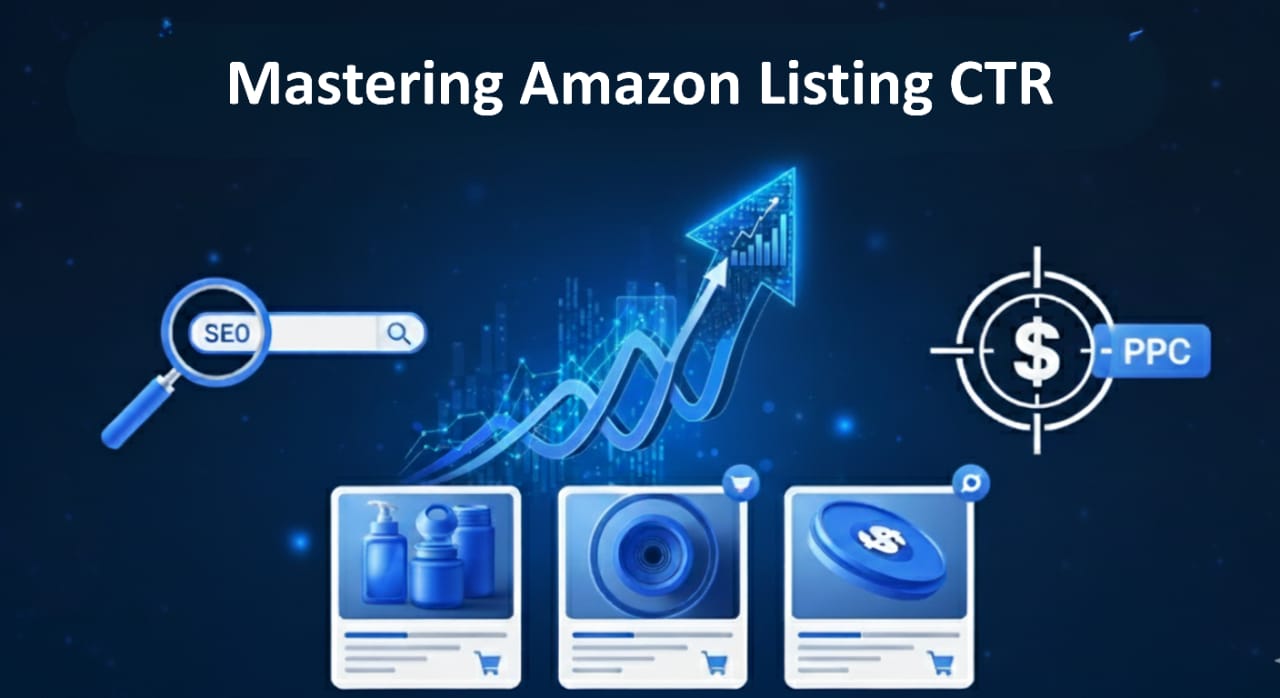Click-through rate (CTR)
Click-through rate (CTR) is one of the most crucial yet often misunderstood performance metrics on Amazon. Whether you’re optimising your product listings for organic visibility or running high-converting PPC campaigns, understanding and improving CTR is key to growing your sales on the world’s largest e-commerce platform.
In this blog, we’ll explore the fundamentals and advanced insights into Amazon CTR—what it is, why it matters, how it varies across placements, and actionable strategies to improve it.
What is Amazon CTR?
CTR (Click-Through Rate) is the percentage of people who click on your listing or ad after seeing it. It’s calculated as:
CTR = (Clicks / Impressions) x 100
For example, if your product ad was shown 1,000 times and received 50 clicks, your CTR is 5%.
Why CTR Matters on Amazon
CTR is more than just a metric—it’s a signal of relevance and appeal. Here’s why it’s critical:
1. Performance Indicator
High CTR indicates that your product image, title, and price are appealing to customers.
2. Affects Ad Efficiency
Amazon uses CTR to help determine which ads to show and how much you’ll pay per click. Higher CTRs often result in lower CPCs (cost per click).
3. Impacts Organic Rankings
For organic listings, Amazon’s A9 algorithm rewards listings with better engagement. A consistently high CTR can help you rank higher organically.
4. Boosts Conversion Funnel
CTR is the top-of-funnel metric. Better CTR means more traffic, which can result in more conversions if your listing is well-optimised.
Understanding CTR Across Amazon Placements
CTR can vary widely depending on where your listing or ad appears. Let’s look at how CTR behaves across different placements with real-world context:
1. Search Results (Organic & Sponsored)
This is the most competitive placement on Amazon. When a shopper searches for a product, dozens of listings appear. Your CTR here depends on how well your main image, title, price, and reviews stand out.
Typical CTR: 0.3% – 2%
Importance: These are high-intent shoppers. Capturing clicks here can drive both conversions and improve organic rankings.
2. Product Detail Pages (Sponsored Display Ads)
Sponsored Display ads often appear on product pages of similar or complementary items. Since the customer is already browsing a product, CTR here is generally lower.
Typical CTR: 0.1% – 0.4%
Tip: Success here depends on smart targeting. Show ads for accessories or alternatives that are highly relevant to the viewed product.
3. Top of Search (First Page)
This is the prime real estate on Amazon. Listings and ads shown here benefit from maximum visibility and usually get the highest CTRs.
Typical CTR: 1%-5%+
Why It Matters: These placements are often dominated by sponsored products and brands. Strong, creative and competitive offers can yield high engagement.
4. Amazon Homepage and Browse Pages
Ads on Amazon’s homepage and browse categories generally see lower CTRs, typically around 0.05% to 0.2%, since shoppers here are browsing more broadly with less intent. These placements are ideal for brand awareness and discovery. Creative, eye-catching ads that highlight lifestyle benefits tend to perform best.
5. Mobile vs Desktop CTR Differences
Over 70% of Amazon traffic is mobile, where CTRs can be 10-20% lower than desktop due to faster scrolling and smaller screens. Mobile-optimized images and concise titles are essential to capture clicks on handheld devices, while desktop allows for more detailed content.
How to Improve CTR on Amazon
-
- Optimize main images – use clear, high-resolution visuals, lifestyle shots, and infographics that instantly highlight benefits.
-
- Write compelling titles – keyword-rich yet natural, avoid duplication, add emotional triggers, and keep it easy to scan.
-
- Use competitive pricing – smart price positioning with visible discounts, coupons, or deals to create urgency.
-
- Build strong reviews – aim for higher star ratings, consistent feedback, and social proof that builds trust at first glance.
-
- Leverage badges & deals – “Best Seller,” “Amazon’s Choice,” and limited-time offers that catch shopper attention quickly.
-
- A/B test creatives – experiment with titles, images, and A+ content to continuously refine what drives the most clicks.
Advanced Tips: CTR in Amazon PPC
For Sponsored Products, Sponsored Brands, and Sponsored Display, CTR is vital. Here’s how to maximize it:
Use Relevant Keywords
-
- Avoid broad match waste
-
- Focus on high-intent keywords
Target High-CTR Placements
-
- Bid for “Top of Search” using placement modifiers
-
- Monitor CTR by placement in campaign manager
Ad Copy and Creative
-
- Sponsored Brands: Use engaging headlines and brand logo
-
- Sponsored Display: Use lifestyle images if possible
Final Thoughts: CTR is the Gateway to Sales
CTR is your first impression on Amazon. If shoppers aren’t clicking, they’re not buying. By understanding what drives clicks—great titles, images, pricing, reviews, and strategic ad placements—you can dramatically improve your Amazon performance.
Focus on CTR as a leading metric, not just a vanity number. Monitor, test, and optimise continuously. Because in the competitive world of Amazon, every click counts.
Need help decoding your SQP data or optimizing your Amazon strategy? Feel free to reach out – we’d love to support your growth on Amazon.


